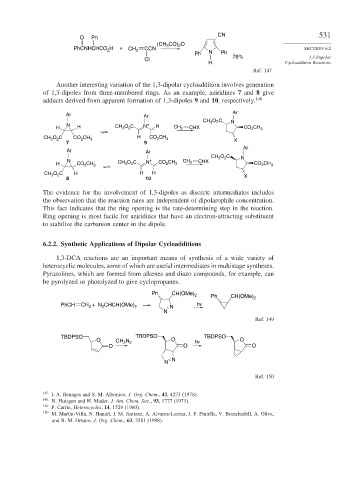Page 557 - Advanced Organic Chemistry Part B - Reactions & Synthesis
P. 557
CN 531
O Ph
2
(CH 3 CO) O
PhCNHCHCO H + CH 2 CCN SECTION 6.2
2
Ph N Ph
Cl 78% 1,3-Dipolar
H Cycloaddition Reactions
Ref. 147
Another interesting variation of the 1,3-dipolar cycloaddition involves generation
of 1,3-dipoles from three-membered rings. As an example, aziridines 7 and 8 give
adducts derived from apparent formation of 1,3-dipoles 9 and 10, respectively. 148
Ar
Ar Ar
O 2 C
CH 3 N
N +
H H CH O C N – H CH 2 CHX CO CH 3
2
3
2
O C CO CH H CO CH
CH 3 2 2 3 2 3 X
7 9
Ar
Ar Ar
O C
CH 3 2 N
N + CO CH CHX
H CO CH 3 CH 3 O C N – 2 3 CH 2 CO 2 CH 3
2
2
CH O C H H H X
3
2
8 10
The evidence for the involvement of 1,3-dipoles as discrete intermediates includes
the observation that the reaction rates are independent of dipolarophile concentration.
This fact indicates that the ring opening is the rate-determining step in the reaction.
Ring opening is most facile for aziridines that have an electron-attracting substituent
to stabilize the carbanion center in the dipole.
6.2.2. Synthetic Applications of Dipolar Cycloadditions
1,3-DCA reactions are an important means of synthesis of a wide variety of
heterocyclic molecules, some of which are useful intermediates in multistage syntheses.
Pyrazolines, which are formed from alkenes and diazo compounds, for example, can
be pyrolyzed or photolyzed to give cyclopropanes.
Ph CH(OMe) 2
Ph CH(OMe) 2
PhCH CH + N CHCH(OMe) 2 N hν
2
2
N
Ref. 149
TBDPSO TBDPSO TBDPSO
O CH 2 2 O hν O
N
O O O
N
N
Ref. 150
147
I. A. Benages and S. M. Albonico, J. Org. Chem., 43, 4273 (1978).
148 R. Huisgen and H. Mader, J. Am. Chem. Soc., 93, 1777 (1971).
149 P. Carrie, Heterocycles, 14, 1529 (1980).
150
M. Martin-Villa, N. Hanafi, J. M. Jiminez, A. Alvarez-Larena, J. F. Piniella, V. Branchadell, A. Oliva,
and R. M. Ortuno, J. Org. Chem., 63, 3581 (1998).

